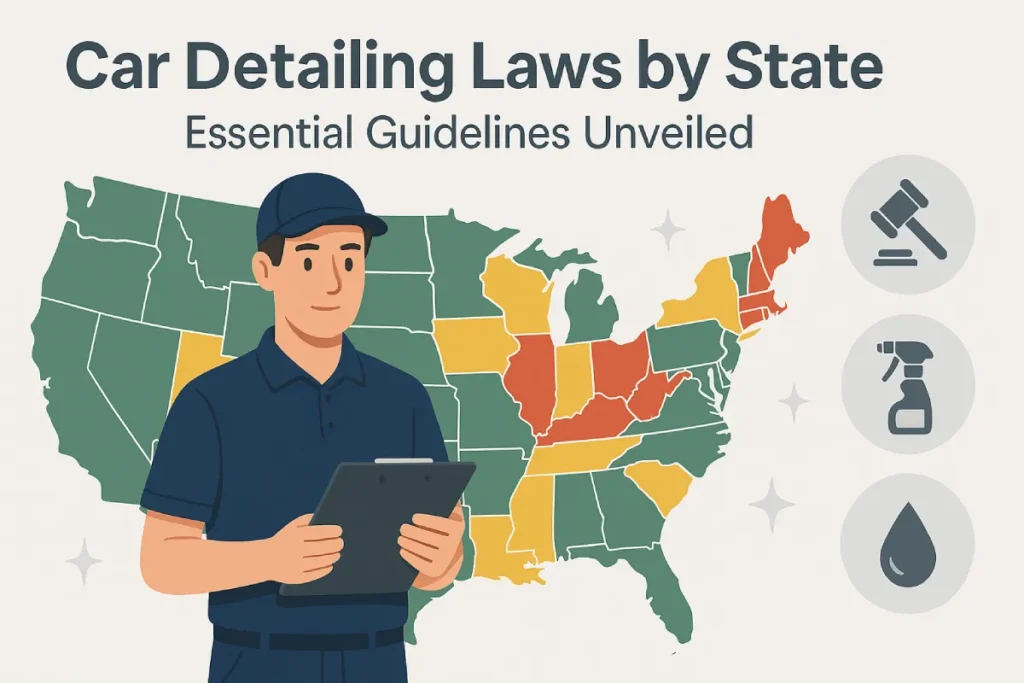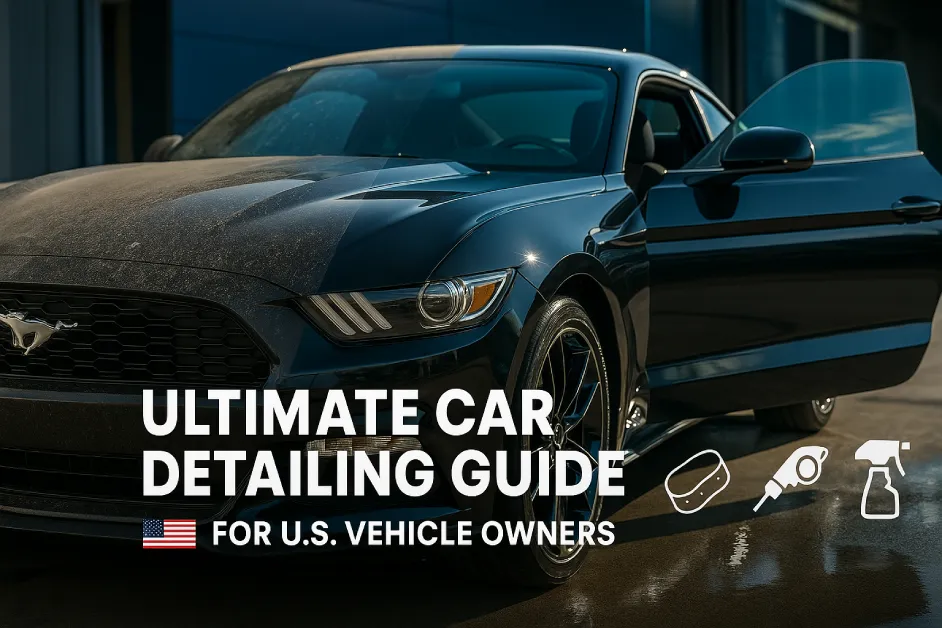When it comes to protecting your car’s paint, the choices can be overwhelming. You might find yourself wondering whether waxing, sealing, or ceramic coating is the best option for your vehicle.
Each method promises to enhance the appearance and longevity of your car’s finish, but which one truly delivers on its promise? Imagine driving a car that not only turns heads but also maintains its shine and vibrancy for years. A car that resists the everyday threats of dirt, UV rays, and harsh weather conditions.
This isn’t just a dream; it’s a reality that you can achieve by selecting the right protection method. But how do you make that choice? By the end of this article, you’ll have a clear understanding of the differences between waxing, sealing, and ceramic coating. You’ll be equipped with the knowledge to make an informed decision that suits your lifestyle and budget. Ready to discover which option will give your car the sparkling shield it deserves? Let’s dive in!
Waxing Basics
Choosing between waxing, sealing, and ceramic coating depends on your needs. Waxing offers shine and protection but fades quickly. Sealing lasts longer, enhancing durability. Ceramic coating provides superior protection and gloss but at a higher cost. Each option has unique benefits for vehicle care.
Waxing is one of the oldest and most cherished methods for protecting a car’s paint. It offers a gleaming finish that many car enthusiasts swear by. But what makes waxing so appealing? Is it the ease of application or the satisfaction of buffing out that perfect shine? Let’s dive into the basics of waxing and discover how it compares to other paint protection methods.
Natural Vs Synthetic Wax
Natural waxes, like carnauba, are derived from plants and are highly favored for their deep, warm glow. They are perfect for the car owner who loves detailing their vehicle regularly. However, they may not last as long as synthetic waxes. Synthetic waxes, made from chemicals, offer durability and longevity. They are great for those who prefer fewer frequent applications. But some argue they lack the depth of shine that natural wax provides.
Application Techniques
Applying wax can be a rewarding experience. You can do it by hand with a foam applicator or use an electric buffer for larger areas. Each method has its own charm and effectiveness. Hand application gives you control and precision, allowing you to reach every corner. Using a buffer can be faster and ensures an even coat, especially on large surfaces. Whichever method you choose, remember to apply in small, circular motions for best results.
Pros And Cons
Waxing offers a beautiful shine and can hide minor surface imperfections. It’s relatively inexpensive and easy for most car owners to do at home. However, it requires regular reapplication, usually every few months, to maintain protection. On the downside, waxing doesn’t provide as robust a defense against environmental elements as other methods. It’s more about aesthetics than long-term protection. So, do you prefer the ritual of waxing or the convenience of a longer-lasting solution?
Sealing Essentials
When you’re aiming for that flawless shine on your car, understanding sealing essentials can be your game-changer. Sealants offer a protective barrier that keeps your vehicle looking fresh and gleaming. If you’ve ever wondered how professionals keep their cars in top-notch condition, sealants are often their secret weapon.
Types Of Sealants
Sealants come in various forms, each with its own unique benefits. Polymer-based sealants are popular due to their longevity and ease of application. They provide a slick finish that repels water and dirt. Acrylic sealants, on the other hand, are known for their durability and glossy finish. You might choose this type if you’re after that deep, mirror-like shine.
Another option is hybrid sealants that combine the properties of polymers and acrylics. These can offer the best of both worlds, giving you durability and a stunning finish. Consider your priorities: do you want ease of application, or is durability your main concern? Choose accordingly.
Durability And Protection
Durability is a key consideration when selecting a sealant. Polymer sealants can last for six months or more, depending on your driving conditions. Have you ever found yourself frustrated with frequent reapplication? Sealants can save you that hassle.
Acrylic sealants, while slightly less durable, provide unmatched shine and protection against UV rays. If your car spends a lot of time in the sun, this might be your best bet. Hybrid sealants offer a balanced approach, providing both decent durability and excellent protection.
Application Process
Applying sealants is straightforward, but it’s all about technique. Start with a clean, dry surface. If you’ve ever tried applying a sealant on a dirty car, you know it’s not a pleasant experience. Use a microfiber cloth for even application.
Work in small sections to ensure thorough coverage. This helps avoid streaks and uneven spots. After applying, let it cure for the recommended time before buffing it out. Have you ever felt the satisfaction of a perfectly sealed car? It’s worth the effort.
Sealing your car not only enhances its appearance but also offers vital protection. Think about what your car faces daily: road grime, bird droppings, harsh sunlight. A sealant can be your car’s best defense against these elements. What’s stopping you from giving it a try?
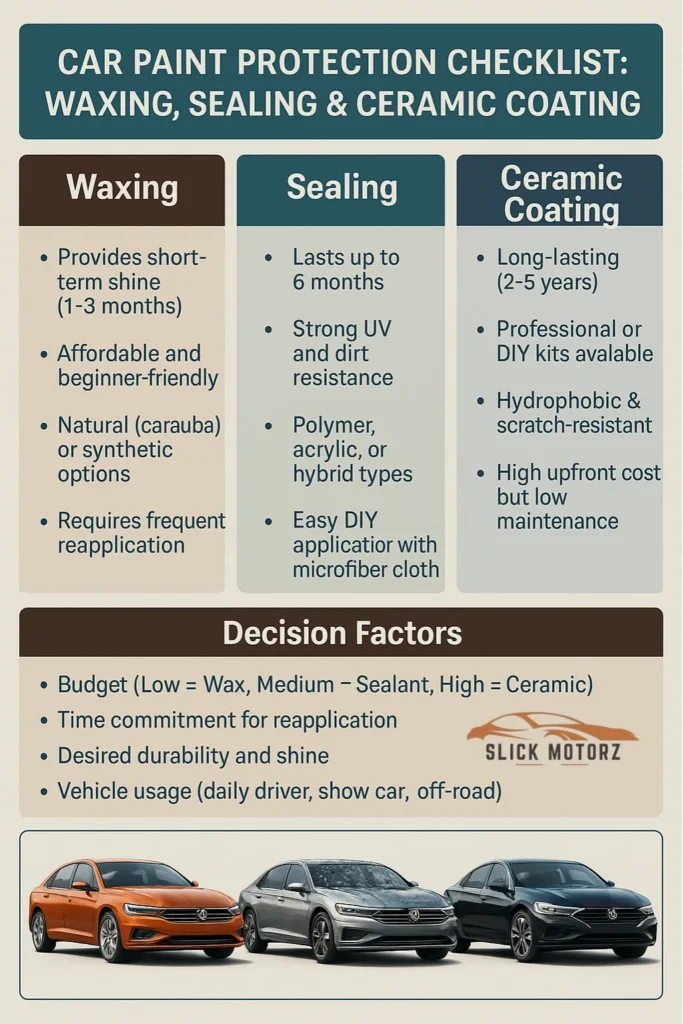
Ceramic Coating Features
Ceramic coating offers superior protection compared to traditional waxing and sealing methods. It forms a durable shield against dirt and scratches. This advanced layer enhances shine and longevity, making it an ideal choice for vehicle care.
Ceramic coating offers a modern solution for vehicle protection. It stands out due to its composition and benefits, long-term effects, and application methods. This advanced option provides a durable shield for your car, enhancing its appearance and longevity.
Composition And Benefits
Ceramic coatings consist of liquid polymers. These polymers bond chemically with the vehicle’s paint. This bond creates a protective layer. Unlike traditional wax, ceramic coatings offer superior resistance. They guard against UV rays, chemicals, and dirt. The coating gives a glossy finish, making cars look new. Its hydrophobic nature ensures water rolls off easily. This feature reduces water spots and stains.
Long-term Effects
Ceramic coatings last longer than wax or sealants. Their durability ranges from one to five years. This longevity depends on the product used and maintenance. Over time, vehicles maintain their shine and protection. Paint remains vibrant, reducing the need for frequent detailing. Owners save time and money, while enjoying a pristine vehicle appearance.
Professional Vs Diy Application
Applying ceramic coating can be done professionally or DIY. Professional application ensures flawless results. Experts use specialized tools and techniques. This method guarantees uniform coverage. DIY kits are available for enthusiasts. These kits come with instructions and necessary tools. DIY application requires patience and attention to detail. Beginners might struggle with even application. Professional services offer peace of mind but at a higher cost.
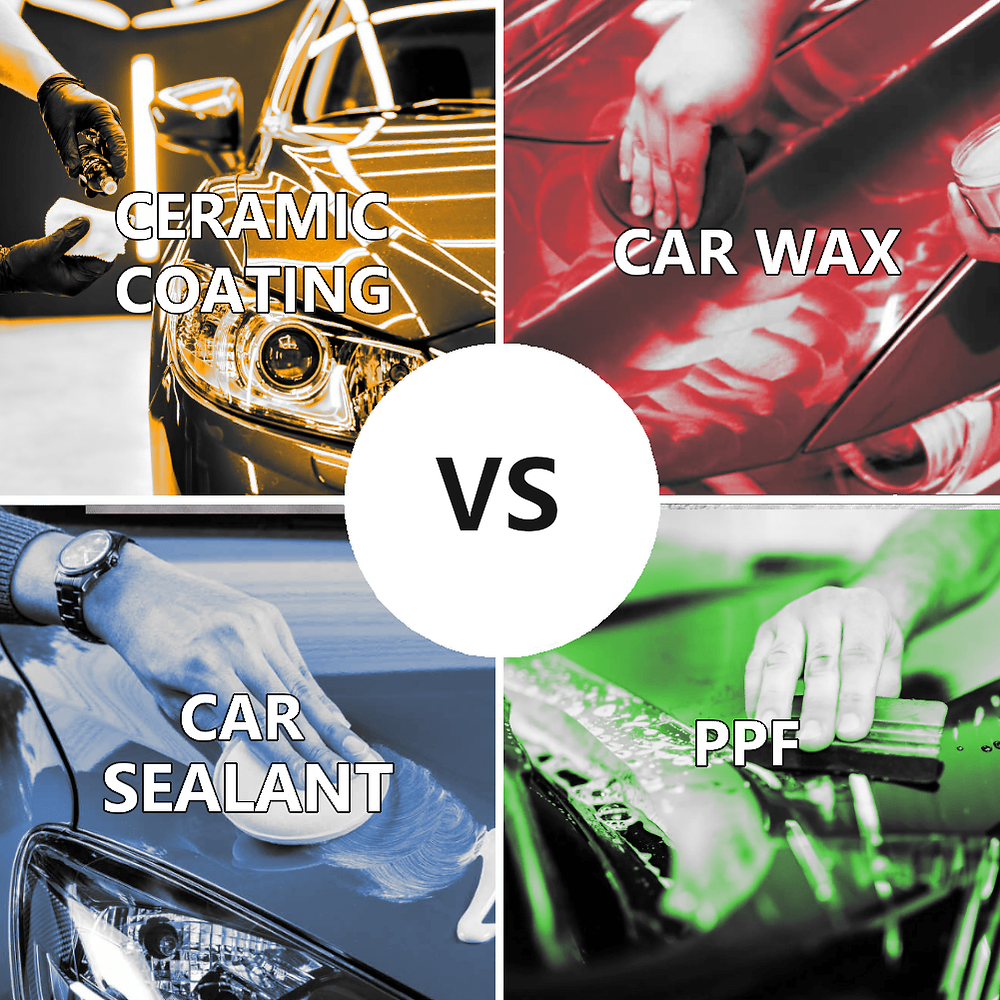
Credit: www.ceramiccoatexpert.com
Comparing Durability
Waxing offers basic protection but requires frequent applications. Sealing provides longer-lasting defense against elements, lasting a few months. Ceramic coating delivers superior durability, often lasting years, shielding against scratches and UV damage.
When it comes to maintaining your car’s shine, understanding the durability of waxing, sealing, and ceramic coating is crucial. Each method offers unique benefits, but how do they stack up against each other over time? Let’s dive into the details to help you decide which is the best fit for your vehicle and lifestyle.
Longevity Of Each Method
Waxing provides a short-term solution for car protection. Typically, you might expect a wax to last anywhere from one to three months, depending on environmental conditions and washing frequency. If you love the ritual of car care and don’t mind reapplying, waxing could be your go-to. Sealing offers a middle ground, with durability lasting up to six months. It’s a great option if you want more long-lasting protection without committing to ceramic coating. Sealing requires less frequent application than waxing, making it ideal for busy schedules. Ceramic coating stands out with its long-lasting protection, often exceeding two years. It’s a solid investment if you’re looking for a low-maintenance solution. Once applied, your car stays protected with minimal upkeep, saving you time in the long run.
Resistance To Environmental Factors
Wax acts as a barrier against water and UV rays but is vulnerable to rain and heat. You might find yourself reapplying wax more often if your car is exposed to harsh weather conditions. It’s perfect for those living in mild climates. Sealing offers better resistance to elements like acid rain and bird droppings. It’s a reliable choice if your car is parked outdoors frequently. This method provides peace of mind knowing that your vehicle is better shielded from daily environmental stressors. Ceramic coating excels in resisting environmental challenges, including chemicals, scratches, and UV rays. It’s like giving your car a permanent shield against the elements. Consider this option if you prioritize maximum protection and have the budget for an upfront investment. Choosing between waxing, sealing, and ceramic coating depends on your personal priorities. Do you enjoy the hands-on approach of waxing, or prefer the hands-off durability of ceramic coating? Whichever path you choose, understanding the durability of each method will ensure your car remains a head-turner on the road.
For more technical comparisons, the Chemical Guys Blog offers expert insights on detailing products and protection longevity.
Cost Analysis
When choosing between waxing, sealing, and ceramic coating for your vehicle, understanding the cost implications can be crucial. Not only does it affect your wallet today, but it also influences the long-term maintenance costs. Let’s break down the initial investment and maintenance costs associated with each option, so you can make a savvy decision for your car’s protection.
Initial Investment
Waxing is the most budget-friendly option. A decent quality wax can cost you around $20 to $50, with professional application ranging from $100 to $200. It’s affordable but requires frequent applications.
Sealing offers a middle ground, with initial costs typically between $100 and $300 for DIY kits. Professional sealing might bump it up to $200 to $600. It lasts longer than wax but requires a bit more upfront investment.
Ceramic coating is the premium choice. DIY kits can start at $100, but professional applications can soar to $500-$2,000. It’s a hefty initial investment, but its longevity might save you money down the line.
Maintenance Costs
With waxing, expect to reapply every few months. Regular touch-ups might cost you an additional $50 to $100 annually. It’s manageable but requires commitment.
Sealants extend your maintenance intervals, lasting up to six months. You might spend around $100 annually for upkeep, saving you time and effort compared to waxing.
Ceramic coatings are built for the long haul. Their maintenance is minimal, often requiring only occasional detailing. This can save you hundreds annually, offsetting that initial investment.
Which option aligns with your budget and lifestyle? Are you ready to invest upfront for long-term savings, or prefer a lower initial cost with more frequent upkeep?
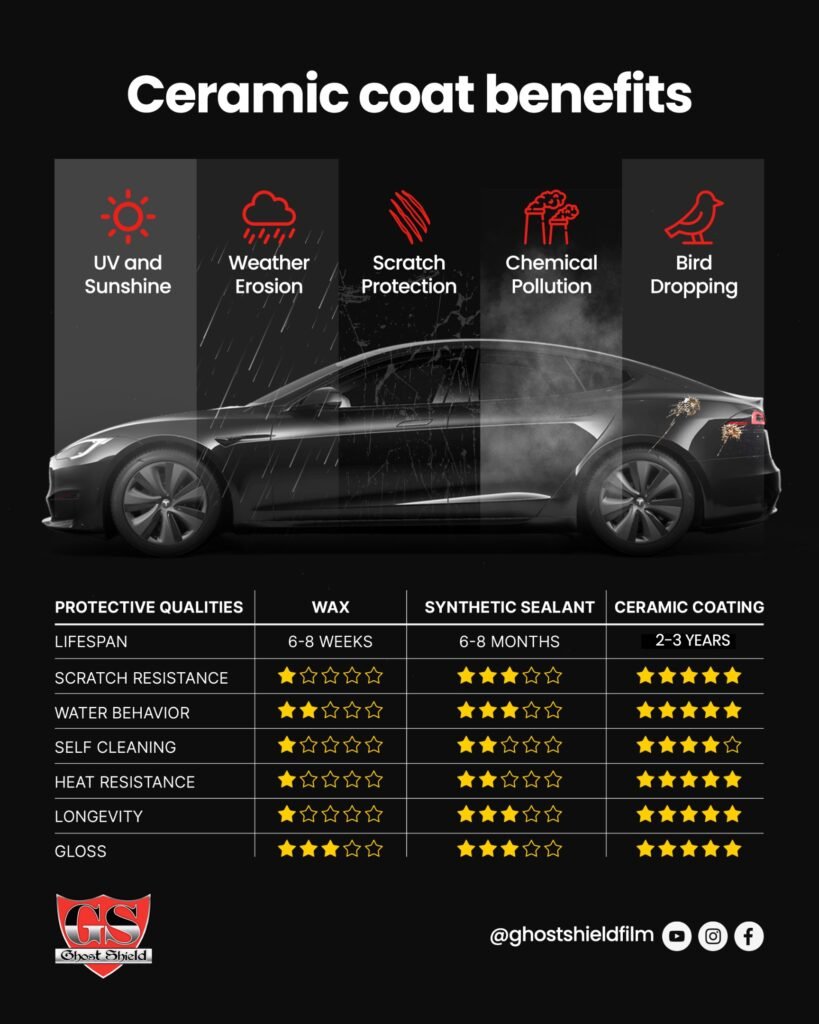
Credit: ghostshieldfilm.com
Ease Of Application
When choosing between waxing, sealing, and ceramic coating for your vehicle, one crucial factor to consider is the ease of application. How simple is it for you to apply these products? This aspect can significantly influence your decision, especially if you’re planning to do it yourself. Let’s delve into what you need in terms of skill, time, and effort.
Skill Level Required
Waxing is the most beginner-friendly option. Even if you’ve never waxed a car before, you can learn quickly. Just apply the wax with a foam applicator and buff it out.
Sealing requires a bit more precision. You need to ensure even coverage for effectiveness. But don’t worry, it’s still manageable with some practice.
Ceramic coating, however, demands a higher skill level. It’s not just about applying; it’s about prepping the surface meticulously. Any small mistake can affect the final result.
Time Commitment
Waxing is quick. You can complete the process in under an hour. Perfect for those busy weekends when time is tight.
Sealing takes a bit longer. You might spend a couple of hours ensuring every inch of your car is covered. It’s a commitment, but the results last longer.
Ceramic coating requires patience. Expect to spend several hours, possibly over multiple days. The prep work alone can be time-consuming, but the durability is unmatched.
Have you considered the time you can dedicate to maintaining your vehicle’s shine? Each option offers different benefits and suits different lifestyles. Your choice may reflect how much time you’re willing to invest and your comfort level with the application process. What suits your schedule and skills best?
Aesthetic Impact
Your car’s aesthetic impact is crucial to its overall appeal. The right treatment can make your vehicle stand out, turning heads as you drive down the street. Waxing, sealing, and ceramic coating each offer unique benefits in enhancing your car’s appearance. But how do they affect the gloss, shine, and color of your vehicle? Let’s dive into these aspects to help you make an informed decision.
Gloss And Shine
Waxing is like giving your car a temporary facelift. It adds a layer of gloss that makes the paint gleam under sunlight. This is perfect for that weekend car show or special event. However, it’s a short-term solution, often fading after a few washes.
Sealing, on the other hand, provides a more durable shine. It forms a protective barrier that withstands the elements better than wax. If you love seeing your car shine consistently, sealants might be your go-to option.
Ceramic coating, however, takes gloss and shine to a whole new level. It bonds with your car’s paint, creating a mirror-like finish that lasts for years. It’s like having your car permanently dressed to impress. Ever wondered what it would be like to have your car look brand new every day?
Color Enhancement
Waxing can enhance your car’s color by adding depth, but this effect is temporary. Think of it as makeup—you apply it for a short-term enhancement. If you enjoy frequent touch-ups, waxing might suit your lifestyle.
Sealants offer a longer-lasting solution for color enhancement. They protect against fading and oxidation, keeping your car’s color vibrant over time. If you drive your car daily, a sealant could be beneficial for maintaining its allure.
Ceramic coating takes color enhancement up a notch. It protects against UV rays and environmental contaminants, preserving the rich hues of your car’s paint for years. Imagine your car’s color remaining vivid even after countless road trips and adventures. Wouldn’t that be a sight to behold?
Each option has its perks, but your choice depends on what you value most—short-term glam, medium-term resilience, or long-term elegance. What’s your preference?
Maintenance Considerations
Maintaining your car’s shine and protection can be a challenge. Each method—waxing, sealing, and ceramic coating—comes with its own care needs. Understanding these requirements can help you decide which option suits your lifestyle and budget.
Routine Care Requirements
Waxing requires frequent applications to maintain its protective layer. Typically, wax needs reapplication every two to three months. This keeps your car looking fresh and protected against minor scratches and UV damage.
Sealants offer longer-lasting protection compared to wax. Reapplying sealant every six months usually suffices. This routine helps maintain its glossy appearance and shields the paint from environmental elements.
Ceramic coatings require the least maintenance. They provide a durable protective layer that lasts for years. Regular washing with pH-neutral soap is essential to preserve its hydrophobic properties. This routine ensures the coating remains effective in repelling dirt and water.
Repair And Reapplication
Wax repairs are simple and inexpensive. You can easily buff out minor imperfections. Any damaged areas can be spot-treated without much hassle.
Sealants might need professional attention for repairs. They require careful application to blend with the existing layer. This ensures a uniform look and protection.
Ceramic coatings demand professional intervention for repairs. Damaged coatings often need complete reapplication. This process is complex, requiring skilled technicians for optimal results.
Choosing The Right Option
Deciding between waxing, sealing, or ceramic coating can be confusing. Each option offers unique benefits. Understanding your needs helps make the right choice. Consider factors like personal preference, vehicle type, and usage.
Personal Preference Factors
Your preference plays a big role. Some prefer the classic shine of wax. Others like the long-lasting protection of ceramic coatings. Waxing needs regular application but gives a deep shine. Sealants offer good protection with less frequent reapplication. Ceramic coatings provide the most durable protection, lasting years. Think about how much maintenance you’re willing to do. Your aesthetic preference matters too.
Vehicle Type And Usage
Your vehicle type affects your choice. Daily drivers benefit from sealants or ceramic coatings. These options provide better protection against the weather and dirt. For show cars, waxing might be ideal. It enhances shine and is easy to apply before events. Consider how often you use your vehicle. Off-road vehicles face harsher conditions. Ceramic coatings offer robust protection against scratches and mud. A family car might need less maintenance. Sealants strike a balance between ease and protection.
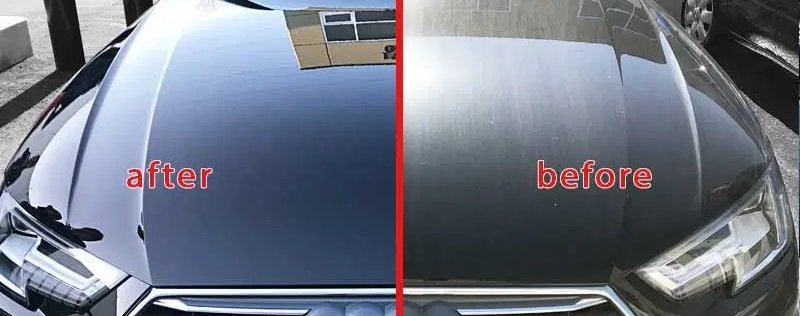
Credit: sandiego-autodetail.com
Frequently Asked Questions
Is It Better To Wax Or Ceramic Coat?
Ceramic coating offers better protection and lasts longer than wax. Wax is cheaper and provides a glossy finish. Choose ceramic for durability and wax for cost-effectiveness. Both enhance your car’s appearance, but ceramic coating is more resistant to environmental damage, while wax needs frequent reapplication.
Should I Use Wax Or Sealant On My Car?
Use wax for a deep shine and traditional protection. Opt for sealant for longer-lasting protection and easier application. Both enhance your car’s appearance but vary in longevity and finish. Choose based on your priority: glossy look or durability. Regular maintenance is key for optimal results.
Is Sealant Better Than Ceramic Coating?
Sealant provides temporary protection and gloss but lacks durability. Ceramic coating offers long-lasting protection and enhanced shine. Choose ceramic coating for superior defense against environmental damage.
What Comes First, Ceramic Coating Or Wax?
Apply ceramic coating before wax. Ceramic coating bonds with the paint, providing a durable layer. Wax enhances shine and adds extra protection. Ensure the surface is clean and dry before application. This order maximizes the benefits of both products and extends the vehicle’s protection and appearance.
Conclusion
Choosing between waxing, sealing, and ceramic coating depends on needs. Waxing offers shine and protection. Sealing provides durability. Ceramic coating offers long-lasting protection. Each option has benefits and drawbacks. Consider budget and maintenance preferences. Waxing is easy and affordable. Sealing lasts longer than wax.
Ceramic coating requires professional application but lasts the longest. Think about how often you use your vehicle. How much time can you spend on upkeep? Choose the right option for your lifestyle. Protect your car’s paint and keep it looking great.
For more tips, see our guide on “Essential Car Detailing Tools” and “Beginner’s Guide to Car Detailing” to maintain that fresh, detailed look between professional services.
Make an informed choice for your vehicle’s care.











